Trucks have become increasingly complex over the last few years. Generations of mechanics were once able to easily adapt to changes in truck technology over the span of a career. In some ways, servicing engines became easier as new production advancements appeared.
For instance, when did any of us last adjust the connecting rod shims for rods with poured babbit bearings? Or how about replacing ignition distributer points and adjusting the dwell? Of course, as those who carried out such procedures on a daily basis years ago know, once you knew how to do the job, the only other knowledge needed was the specifications.
So, being curious about the extent of information needed back then to maintain and overhaul some of those engines, I took a look at an aftermarket service manual covering the years 1941-1950 for trucks, buses and tractors. The Mack EO, EP, and EY model engines covered in that 10- year span take up a total of five 9×6-in. pages, much of which is used for cut-away illustrations of the entire engine.
Today, engines need to meet ever-increasing emission requirements while at the same time increasing in power output as well as efficiency. As a result, the technology necessary to provide clean, efficient and powerful engines is more refined than ever before. Many engines now have upwards of 1,000 diagnostic trouble codes that alert the technician to a problem detected in the system.

With the complexities existing in these engine systems, a scan tool or web-based diagnostic software program like TruckSeries from Mitchell 1 is essential to retrieve DTCs from the vehicle, as well as to observe operational data during diagnosis. Today’s repair information includes a wealth of data including specifications, test procedures, component locations and operations, complex wiring diagrams, remove and replace procedures and more; all relating to a single DTC. Without a way to see the various inputs and outputs in the engine control system during operation, the technician simply cannot properly identify and resolve system faults.
Of course, the tech could make a best guess without this information. However, the likelihood of a mis-diagnosis resulting in increased repair cost and downtime would go up considerably. Taking the time to obtain a diagnostic testing device that will support the vehicles entering the shop is time well spent.
Still, diagnostics do not end with reading the electronic inputs and outputs from the engine. Once the DTCs are retrieved, it is time to turn to the diagnostic testing and other related information. Knowing what steps to follow in order to quickly and efficiently resolve the DTC remains a key point in diagnostics.
Servicing today’s trucks demands access to a massive amount of information. Long past are the days when a half-dozen pages of information would cover an engine for a decade. Now, the printed diagnostic service information for 10 years on a single engine would fill a sizable shelf. Add in the service information for all the vehicles and it may be time to knock down a wall to extend the shop library.
Having access to the service information digitally not only saves space, it makes bringing the needed information such as the fault description, testing, wiring diagrams, connectors and repair procedures together so much faster and easier. Type in the DTC and all the related information is delivered in seconds. Plus, one last benefit: there are no more greasy pages like in that 60-year-old shop manual.
Additional tips for repair and maintenance of Class 4-8 trucks may be found in the Mitchell 1 ShopConnection Truck blog: mitchell1.com/shopconnection/category/truck.
Jake Schell is the associate product manager for Mitchell 1’s Commercial Vehicle Group.














